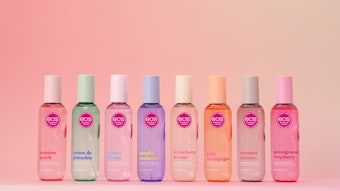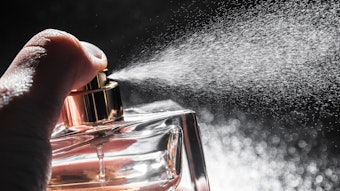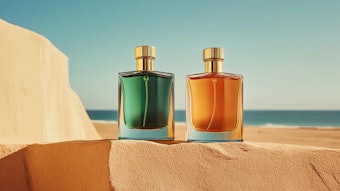- Consumers identify strongly with scent, and what’s more, they identify quality scents with beauty, glamour and elegance—target attributes for the cosmetic industry.
- Fragrance assists in telling a brand’s story, particularly if similar scents are used throughout the brand’s range of products.
- Fragrance can help match a product to its purpose, e.g., “invigorating” scents like citrus and mint used in a body wash product.
- All elements of a product—fragrance, packaging, ingredients, benefits, story, texture—need to be balanced and considered to have a successful beauty asset.
Panel:
Patti Allyn, Vice President, Evaluation, Consumer Goods, Mane, USA
Amy Braden, Director of Product Development, Tru Fragrance
Wendy Diamond, Vice President, Marketing, Consumer Goods, Mane, USA
Nikki Enriquez, Fragrance Marketing Coordinator, Bell Flavors & Fragrances
Michelle Harper, Director of Fragrance Evaluation, Arylessence
Lori Miller Burns, Director of Marketing, Arylessence
Anne Silsby, Senior Marketing Manager for Bath and Body, Philosophy
Q: Why is a good fragrance important to a beauty product?
Michelle Harper, director of fragrance evaluation, Arylessence: A good fragrance is the key to success of any product. A good fragrance makes using a good product a great experience. Products must always deliver on their intended function. A moisturizer needs to deliver on the consumer’s expectation of moisturizing in order to have a chance at success. So, pair a good moisturizer with the fresh scent of dew-misted florals and crushed greens above glistening musks to create a truly winning combination.
Fragrance also is the game changer at the shelf. A winning fragrance establishes differentiation at the shelf and gives consumers a basis for their purchase choices. A great product with a poor fragrance strategy is likely not to make it into the basket. A good fragrance is not just important, it’s essential, especially in today’s crowded marketplace where consumers have so many choices. At the shelf, especially with a product new to the market, fragrance is often the deciding factor. Memorable fragrances that enhance the consumer product experience lead directly to brand loyalty.
Nikki Enriquez, fragrance marketing coordinator, Bell Flavors & Fragrances: A good fragrance is important to a beauty product because a consumer is not going to buy something that smells bad, especially a beauty product. Beauty products evoke a sense of glamour and elegance, and the fragrance in the product makes or breaks those feelings. Fragrance can create brand loyalty.
Patti Allyn, vice president, evaluation, consumer goods, Mane, USA: Beauty products are first and foremost benefit-driven. Therefore, a superior fragrance will not only enhance the personal experience, it will be the primary signal to the user that the product is delivering its intended benefit.
Anne Silsby, senior marketing manager for bath and body, Philosophy: Fragrance is key to sensory experience—impression, association and inspiration. A beautiful fragrance is the perfect way to elevate your mood and enhance your well-being.
Amy Braden, director of product development, Tru Fragrance: A good fragrance helps create a connection and develops a relationship between a consumer and product. Many consumers choose beauty products based on functionality—fragrance adds an element of pleasure. Scent enhances the experience of using a product and the benefits one associates with it. People want to use products that appeal to them, and that includes fragrance or scent.
Q: Obviously skin care and bath and body products tend to be more fragranced, but what are the challenges and/or opportunities for applying fragrances to color cosmetics and hair care?
Harper: When it comes to color cosmetics, the focus is not on fragrance. Fragrance plays a minor, supporting role if present at all. When fragrance is used in color cosmetics, its primary role is to lightly mask or complement any unpleasant odors that may be present in the base formulation. Masking fragrances are usually very simplistic in composition, often containing only one or two fragrance ingredients.
For hair care, base formulations can be very tricky, specifically in conditioners and hair colorants. Raw materials used in these product bases can often have fatty or amine base odors, which are difficult to cover or complement with fragrance. Our extensive experience with fragrancing difficult bases has taught us to be selective in our fragrance design for these products in order to get the best results. Fragrance compatibility and excellent performance are achievable with perfumer and evaluator expertise.
Enriquez: Adding a fragrance to a color cosmetic or hair care products can become a signature to the brand. Sure, the packaging may change, but if the product stayed the same with the same great fragrance everyone loved, it is perfect (to the consumer). On the flip side, if a product isn’t doing well, maybe that company should look at changing the fragrance in that product. This really makes sense for hair care products. The quantity of hair care products used daily is enormous. If the fragrance in the product is a quality fragrance that impacts its users, you will have customers for life.
Color cosmetics (also) is a very interesting topic because it hits the sense of vision; by adding fragrance to it, you would have a sensorial explosion of see and smell.
Allyn: Actually in the world of prestige personal care products, skin care is not typically a highly fragranced system. This often depends on whether the product is benefit-driven or meant to be a fragrance experience (ala Bath & Body Works). Experiential fragrance products can be 20 times that of the benefit-driven product. Hair care products are unique in that they often deliver both benefit and fragrance simultaneously. In this scenario, the fragrance must complement the action of the hair product. “Moisturizing” with “shea” versus “shine” with “citrus” oils will have very different odor profiles to support their marketing claims.
Silsby: For those companies who choose to add fragrance, the challenge is usually to mask the base odor of the formulation. It requires a balance between delicately covering and not adding too much fragrance in a product that will be applied to the face. For hair care, the challenge is to formulate for a nice fragrance lift in the shower, which requires beautiful top accords while also leaving behind a pleasing yet light scent in the hair.
For opportunities, color cosmetics could incorporate fragrance through a blend of natural essential oils that also provide skin care benefits.
Braden: This is interesting as we’re starting to track some really unique trends in these spaces, and at the forefront is scented nail polish. Where this was typically a category known for an unappealing scent, there’s been a revolution. Industry innovators like Betsey Johnson are exploring nail polish fragrances that mimic eau de toilette, creating a line extension for existing fragrances. Other brands are adding more familiar scents such as fruits and florals.
Another trend we’re starting to see is matching scents to blush and eye shadow colors. For example, if there is a rose-colored blush, it’s scented “rose” to match the name and color. Fragrance adds an element of fun, playfulness and happiness to the product experience. With colors that are so similar to the scents, it’s an obvious match and a natural way to enhance the colors and products.
Q: What elements are important to consider in product fragrances? Packaging colors? Ingredients? A brand’s story?
Lori Miller Burns, director of marketing, Arylessence: Complete sensory connections are central in the success of a product. These cues include visual, aroma and tactile elements. Certainly the packaging message must connect to the position of the product through the packaging materials, the font style and the use of the right colors for the total product message is a top priority. The concept-color-fragrance connection must resonate with the consumer. If my packaging and claims are “blue” (like moisture benefits), does my product smell “blue?” Successful products make these full-circle sensory connections clear to consumers.
Wendy Diamond, vice president, marketing, consumer goods, Mane, USA: Packaging, color tones, callout ingredients and storytelling are all important elements to consider in creating a product. Once target demographics, channel of distribution, price points and a competitive review are established, leveraging a point of difference in product development may be established through a thought-out color story and strong graphic imagery unique to the brand. Additionally, branding may further make a connection through packaging textures, bottle shapes, sizes, labels and closures to help communicate the brand’s message. Key callout ingredients that add beauty benefits should further tie into positioning and support the packaging color and mood.
Silsby: Yes, yes and yes. Packaging colors, shape, size and patterns offer the first visual indication of what may be found within. With only a few seconds to make an impression, the goal is love at first sight. As for ingredients, Philosophy genuinely believes that what is in our jars and bottles must be efficacious, derived from quality ingredients and deliver a beautiful experience. Finally, having a unique story is key to building a lasting relationship in women’s lives.
Braden: There are many to consider, but the first is the packaging as this is often the first exposure that consumers will have to a product or brand. However it’s the fragrance itself, as well as how consumers experience it, that creates the initial relationship. The fragrance must capture the interest and desires of consumers. If they find the fragrance appealing and pleasant, they will come back and buy it again and again.
The brand story is important as well, as this is the driver that will create buzz and consumer interest and consideration. It’s so important that the story is successfully communicated, whether through advertising or by those sampling the product on the floor.
Q: How is a brand fragrance leveraged across a variety of SKUs? Is it changed per product, or does it stay the same? What decisions need to be considered?
Harper: Utilizing a signature scent—or more specifically, a signature accord—is a great strategy for building brand recognition and ultimately brand loyalty. Look to Dove and Herbal Essences as market-proven examples. The halo of Dove’s bar soap scent is present in nearly every Dove variant. For brand loyalists, they not only know a Dove product when they smell it, they expect to find the Dove halo in any new variant launched. Dove’s signature accord is leveraged across body wash, deodorant, hair care and body spritz lines. The same can be said of Herbal Essences products. Its signature apple floral scent is brand heritage and integral to any product bearing the Herbal Essences name.
Not all fragrances translate across product categories. For instance, a holiday spice scent may not translate well in a personal care product. The smell of red hot candies is wonderful as a holiday candle, but would not be a sought-after scent direction for body care, not to mention the regulatory guidelines restricting the use of spice raw materials in various product formats. Fragrance fit should be the determining factor when considering the viability of leveraging a single scent or signature accord across SKUs.
Enriquez: Using similar notes in each fragrance throughout a line is how different SKUs have a similar fragrance type. Decisions for the similar notes are based on what the product is and what is in the base formula.
Diamond: Leveraging a fragrance across multiple SKUs is a decision that changes from brand to brand. It may depend on whether a product is a leave-on or a rinse-off product, (and factors such as) whether it contains certain benefits such as energizing or moisturizing, which can be communicated through the type and level of fragrance.
Silsby: When using a fragrance for different SKUs, sometimes it may remain unchanged and perform within established standards. On other occasions, it must be modified. For instance, shower gel fragrances may need to be adjusted to help with solubility, lift or to rebalance the scent to match the fragrance experience of its corresponding eau de toilette. For lotions, it may be necessary to make a modification if ingredients interfere with the olfactory profile, are needed to offset a base odor or must be enhanced for longevity on the skin.
Braden: A brand fragrance typically starts with a core eau de parfum and can be adjusted by the amount of oil that is added, which is what dictates the strength of the fragrance. Ingredients differ based on the functions you are trying to achieve with each SKU. Over the past 8–10 years, there has been an increase in “flanker” fragrances, where key elements and notes of a fragrance are taken with a slightly different formula to create a seasonal or limited edition version of a fragrance. Typically, these are short-lived, but sometimes can do just as well or better than the original fragrance. One of the biggest examples of success in the space is Coco Mademoiselle, which was a flanker of Coco Chanel. Coco Mademoiselle featured key notes of the original fragrance, but was targeted to younger users. There are also opportunities to expand into additional products, including candles, body lotions and creams, and so on.
Q: Can a “good” fragrance be defined for a specific product type? Does, for example, the fragrance used in a body care product work for a hair care product? Even if they are the same brand, are there different nuances that consumers expect in one over the other?
Harper: A fragrance used in a body care product may be a great fragrance fit for hair care as well. We see examples of this throughout fine fragrance with the ancillary products containing the same scent or a modified version of the scent designed for optimum performance in each specific product. The odor profile of the original fragrance may be tweaked or rebalanced for each product, as well.
For instance, a fragrance modified for shampoo may be rebalanced with increased fresh floral nuances to support the action of shampooing and the perception of cleaning. The fragrance modified for conditioner may need more top notes or possibly more complexity in the base to counteract any unpleasant-smelling ingredients in the product formula. Additionally, a subtle shading of velvety musks could be incorporated to support and enhance the conditioning experience.
Ultimately, the best fragrance for a given product is one that enhances the product’s positioning or function through strategic scent design. A product designed to clean should always have a fragrance that clearly conveys that message. A product designed to smooth or add shine needs a fragrance that enhances those attributes.
Enriquez: What you have to remember is fragrance is chemistry. Certain fragrances do not work in certain bases because the base is either to powerful for that fragrance or the fragrance could not be right for the base (the fragrance could discolor the base). It is not recommended to use the (exact) same fragrance in different bases, because you will get different reactions.
Allyn: Effectively, hair and skin products can have a similarity; however, they are technically designed differently. The expectations per product, even within hair can vary greatly, i.e., fragrances designed to be substantive on hair for styling or a diffusive, highly fragrant experience in the shower for shampoo products. Skin care systems can contain maskants with low odor or be designed to layer as a fine fragrance ancillary.
Silsby: There are many variables in creating a wonderful scent, particularly if you consider the type of fragrance and other elements included in a formula. When designing a fragrance, it is key to inform the perfumers of all the different potential applications for the fragrance, so they can design a profile that translates well in all products.
Q: How do you see fragrance being used to promote brands and branding efforts in the future?
Harper: As product developers, fragrance remains one of the most powerful, yet most underutilized tools in our arsenal. Fragrance is a game changer. The most successful brands know the power of fragrance and use it to unleash the success of their product in the marketplace. Strategic fragrance design represents the future of product branding. Expect to see more seasonal fragrance variants and limited edition offerings within personal care and even home and institutional product categories.
Also, as consumers seek more control over fragrance choice and their own fragrance experiences, they may seek to change the level of fragrance in their products. We expect fragrance delivery systems to be more technology driven to give consumers options to add fragrance on-demand.
Miller Burns: More and more marketers/product developers are realizing the power of fragrance sensory branding when developing their products. In order to stand out in a crowded marketplace, the leading sensory emotional asset—fragrance—must be carefully considered. The right fragrances or winning fragrances establish an essential emotional bond with the product’s targeted consumer. Winning beauty products and brands will offer high-quality fragrances that deliver on consumer’s fragrance expectations, distinctly communicate product benefit and performance messages, and translate the complete product message.
A key to creating winning beauty products in a competitive marketplace is to ensure fragrance is an integral part of your product development process and strategies. In addition, fragrance must be a primary consideration in the earliest product development stages.
Marketers and brand owners can leverage the fragrance success of one beauty product by parlaying it into product line extensions, further establishing consumers as brand fans.
Diamond: Fragrance will remain an excellent component in promoting a brand. As we move forward, I believe that fragrance will play a more cohesive role to the final product and make a better connection to the packaging’s graphics and product positioning for a 360-degree product concept. As the industry gleans more insight into consumer’s preferences, fragrances will also be fine-tuned and better directed to the actual brand’s targeted consumer while also enhancing the product’s benefit claims.
Silsby: The possibilities for fragrance are virtually endless. From new sampling vehicles to advances in fragrance formulation, Philosophy sees fragrance as a brand pillar and a perfect opportunity to begin more beautiful relationships with women everywhere.
Braden: In the retail space in which Tru Fragrance operates, fragrance continues to gain appreciation as an extension and interactive, sensory representation of a brand. We predict that retailers will continue to capitalize on fragrance as an opportunity to extend the emotional connection between consumers and the brands they love.
Fragrances are going to be self-promoting in many ways. Through the use of traditional efforts like scent cards and magazine inserts, fragrance will continue to connect brands directly with potential consumers. This is an easy way to offer consumers the opportunity to experience the fragrance, and therefore the brand, firsthand. What is also interesting is that non-fragrance companies and products are leveraging scent in their branding efforts. Tampons now have “fresh scents” in their commercials, and air fresheners have scratch-and-sniff labels to let consumers test out the scents in-store at retail.










